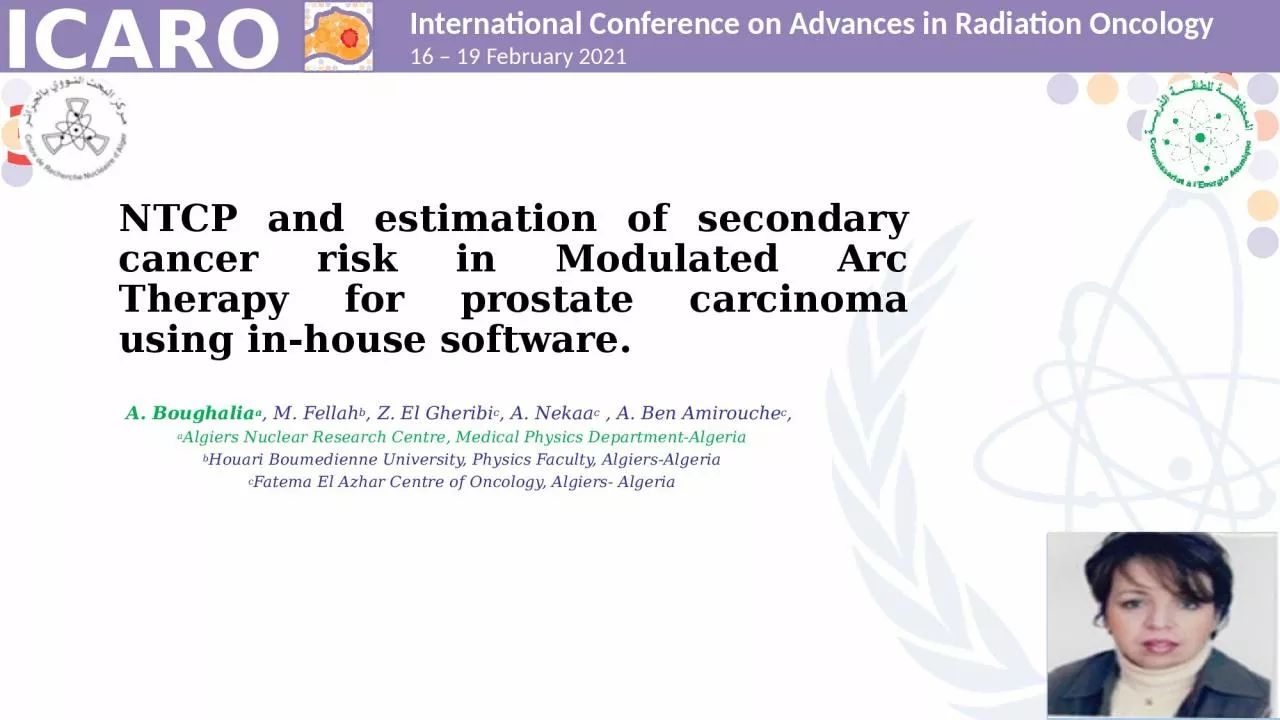

A Boughalia a M Fellah b Z El Gheribi c A Nekaa c A Ben Amirouche c a Algiers Nuclear Research Centre Medical Physics DepartmentAlgeria b Houari Boumedienne ID: 920896
Download Presentation The PPT/PDF document "NTCP and estimation of secondary cancer ..." is the property of its rightful owner. Permission is granted to download and print the materials on this web site for personal, non-commercial use only, and to display it on your personal computer provided you do not modify the materials and that you retain all copyright notices contained in the materials. By downloading content from our website, you accept the terms of this agreement.
Slide1
NTCP and estimation of secondary cancer risk in Modulated Arc Therapy for prostate carcinoma using in-house software.
A. Boughaliaa, M. Fellahb, Z. El Gheribic, A. Nekaac , A. Ben Amirouchec, aAlgiers Nuclear Research Centre, Medical Physics Department-AlgeriabHouari Boumedienne University, Physics Faculty, Algiers-AlgeriacFatema El Azhar Centre of Oncology, Algiers- Algeria
Slide2INTRODUCTION
Prostate cancer ranks third in men's cancers after colorectal and pulmonary cancer in the word. It reaches 10 million in 2020 with 7 million deaths particularly for the developing countries. In Algeria, it was classified at the 4th position after stomach cancer. During the last decade, IMRT is the most applied treatment modality for prostate cancer. It has been implemented for routine in 1995 till today;This evolution has of course improved clinical outcomes of cancer treatment but the toxicity of surrounding cells makes real/increases the probability to induce second cancers. The aim of this study was to evaluate the toxicity of organs at risk and to assess the induction of secondary cancers after radiotherapy. New in-house software “Coupôle” was developed using radiobiological metric such as Normal Tissue Complication Probabilities (NTCP); 2. Estimation the risk for developing secondary cancers after radiotherapy
Slide3METHODS
Twelve patients were treated for prostate Carcinoma with high risk;Medium Age 75 years old; T-Stage: T2aN0M0-T3bN0M0All the PTVs were contoured by the radiation oncologist;Dose distribution was calculated with MONACO System taking into account dose constraints. The treatment was delivered by 18 MV VERSA HD Linear Accelerator, using VMAT modality with single arc in two directions (CW and CCW) Toxicity after radiotherapy:Mathematical Model (Lyman-Kutcher-Burman): II. Estimation of the induced second cancer:
United Nations Scientific Committee on the effect of Atomic Radiation “UNSCEAR”D: is the total dose given to the patient in n fractions;α1 , α2: are linear factors of induction of DNA mutation and the cellular survival;
β1, β2: are quadratic factors
Prostate carcinoma with high risk
CTV1
GTV + ganglions with margin of 5 mm
PTV1
CTV 1 + margin of 8 mm and 5 mm in posterior
CTV2
GTV
PTV2CTV2 + margin of 8 mm and 5mm in posteriorGTVProstate
Definition of differents Targets volumes.
The values of α1 and α2 linear factors of DNA
Mutation and cellular survival processes.
Organ’s at risk
Constraints
Maximum DoseRectumV30 < 60%Dmax < 76 Gy V60 <50% V70 < 25% V74 < 5% BladderV60 <50 %Dmax < 82 Gy V70 < 25%
Constraints dose defined for Rectum and Bladder in case of Prostate cancer with high risk treated with VMAT.
Slide4Experience of 12 patients treated for Prostate CARCINOMA with high risk 76
Gy/38 fractionsRESULTS 1Coronal, Sagittal and Axial view of VMAT planned dose distributions and Dose Volume Histogram was plotted for tumor and OARs (example of one patient’s treatment plan)
MONACO System Calculation and VERSA HD Linear Accelerator treatment
Slide5RESULTS 2
Normal Tissue Complication Probability which induce Rectal Bleeding in case of rectum after radiotherapy
Normal Tissue Complication Probability which induce Fecal incontinence in case of rectum after radiotherapy
Toxicities for organs at risks: 1. Normal Tissue Complication Probability NTCP(%) calculation given by Coupôle vs Biosuite
Toxicities for organs at risks: 2. Risk for secondary cancers after radiotherapy
Risk for secondary cancers for Rectum= 0,066%
Clinically observed risk (0.05-0.20
%
) (Boice et al, 1985)
Risk for secondary cancer for Bladder = 0,0101%
Clinically observed risk (0.15-0.32
%)
(Boice et al, 1985)Normal Tissue Complication Probability to induce Contracture Bladder after radiotherapy
Slide6DISCUSSION
The aim of this study was to evaluate the quality of the VMAT modality with respect to the treatment effect through the NTCP values and the risk for developing secondary cancers after radiotherapy;The calculated NTCPs for each patient revealed that some patients exhibit an NTCP>5% in case of the rectum. However, this is not the case for the bladder, for which all the NTCPs < 5%;A low risk for secondary cancers was found for rectum; There is no associated risk for secondary cancer for the irradiated bladder ;CONCLUSION:1. Evaluation of NTCP and secondary cancer estimates, can improve treatment quality, particularly when complex treatment modalities are involved, 2. Our in-house software Coupôle was validated against Biosuite.Acknowledgements, All my grateful and thanks to Prof. Mohamed Fellah, Prof. Alan. NAHUM and Dr. Julian. UZANThank you